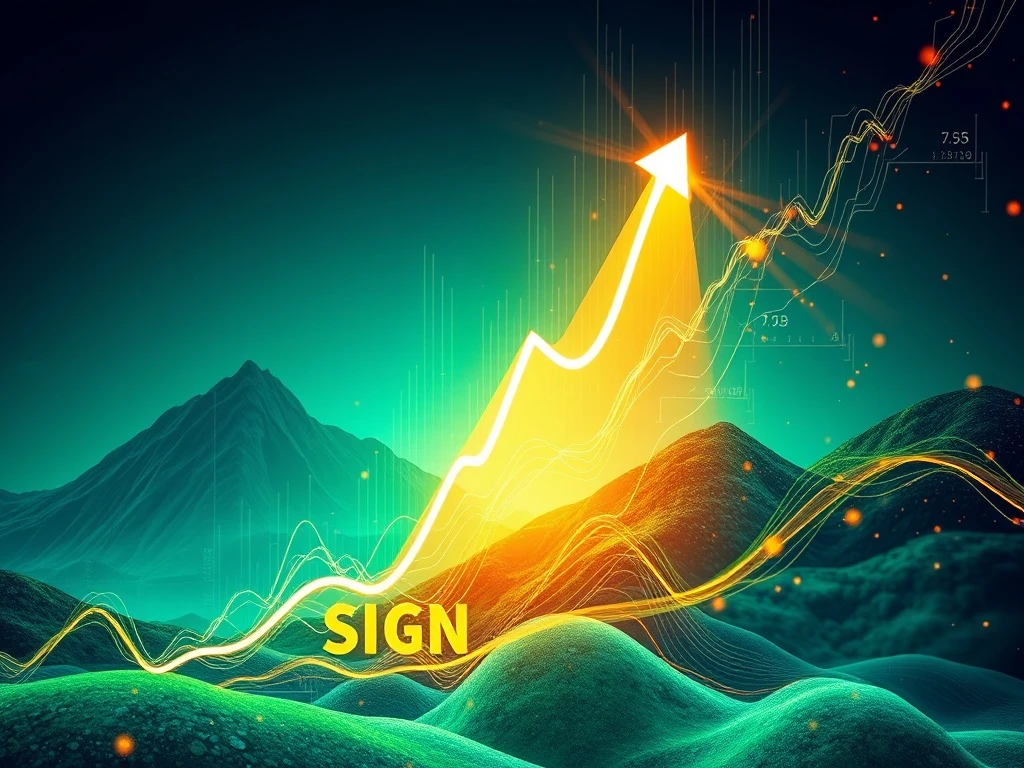SIGN Crypto’s Astonishing 468.93% Surge: Unpacking the Strategic Catalyst

The cryptocurrency market is no stranger to dramatic movements, but some surges truly capture attention. This past Sunday, July 27, 2025, saw the SIGN crypto token achieve an astonishing feat, skyrocketing by 468.93% in just 24 hours to reach $0.08321. This monumental leap isn’t just a fleeting moment of volatility; it signals renewed investor confidence driven by a series of strategic developments and pivotal announcements that have fundamentally reinvigorated interest in the asset.
What’s Behind SIGN’s Explosive Cryptocurrency Surge?
When a digital asset experiences such an impressive gain, the market immediately looks for the underlying catalysts. For SIGN, this surge is a direct result of several calculated moves designed to enhance its ecosystem, utility, and market reach. It’s a testament to the power of consistent development and strategic foresight in the volatile crypto landscape.
Key Drivers of SIGN’s Growth:
- Strategic Partnerships and Ecosystem Expansion: A major factor behind the renewed interest is SIGN’s integration of its blockchain infrastructure with a leading decentralized finance (DeFi) platform. This crucial step enables seamless cross-chain transactions and boosts liquidity for users, significantly expanding the usability of SIGN tokens beyond their native environment. Furthermore, the introduction of a new governance framework empowers token holders, giving them a greater say in key project decisions and fostering stronger community alignment.
- Institutional Adoption and Infrastructure Milestones: The inclusion of SIGN in a growing number of institutional-grade custodial services marks a significant shift. This move signals broader recognition within the traditional financial sector, potentially unlocking substantial new demand from institutional investors seeking secure ways to manage their SIGN holdings. Concurrently, vital infrastructure upgrades, including the launch of a new node network, have drastically improved transaction speed and reduced network congestion. These enhancements are crucial for supporting higher transaction throughput and ensuring efficient operations as the user base expands.
- Community Engagement and Enhanced Token Utility: The development team has wisely prioritized empowering its community and boosting the practical applications of the token. A new staking mechanism now allows holders to earn rewards by participating in network validation, directly contributing to the network’s security and decentralization. Moreover, a community-driven initiative has been launched to fund novel use cases for the token, exploring applications in areas like identity verification and data privacy. This focus on innovation is designed to expand SIGN’s real-world relevance.
The Power of DeFi Integration for SIGN
The integration with a major DeFi integration platform is arguably one of the most impactful developments for SIGN. Decentralized finance is rapidly reshaping the financial world, offering alternatives to traditional banking systems. By seamlessly connecting its blockchain with a prominent DeFi ecosystem, SIGN has not only broadened its reach but also unlocked new avenues for utility and liquidity. This strategic move positions SIGN to become a more integral part of the burgeoning DeFi landscape, attracting a wider array of users and developers looking for interoperable solutions.
How Does Improved Blockchain Infrastructure Benefit Investors?
Behind every successful crypto project is a robust and scalable technical foundation. SIGN’s recent infrastructure upgrades, particularly the launch of a new node network, directly address scalability and efficiency. Improved transaction speed and reduced network congestion mean a smoother, more reliable experience for users. For investors, this translates to greater confidence in the project’s long-term viability and its ability to handle increasing demand. A resilient blockchain infrastructure is critical for sustained growth and user satisfaction.
What Does Institutional Adoption Mean for the Future of SIGN?
The embrace of cryptocurrencies by institutional players is a significant indicator of market maturity and legitimacy. SIGN’s inclusion in institutional-grade custodial services is a powerful endorsement. This development allows large-scale investors – from hedge funds to corporate treasuries – to securely hold and manage SIGN tokens. Such institutional adoption often precedes a broader acceptance and can unlock substantial capital flows, providing a strong foundation for future price stability and growth. It signifies that SIGN is moving beyond niche interest into mainstream financial consideration.
Navigating the Market: Analyst Commentary and Outlook
Analysts are closely watching SIGN’s trajectory, with many projecting continued growth, provided the project consistently delivers on its ambitious roadmap. While the crypto market is inherently volatile, the long-term outlook for SIGN appears promising, supported by a potent combination of technical advancements and strategic partnerships. The recent cryptocurrency surge clearly reflects a renewed wave of confidence in the project’s direction and its capacity to execute its vision. As the SIGN ecosystem matures, maintaining focus on scalability, governance, and further institutional integration will be paramount to sustaining this impressive momentum.
In conclusion, SIGN’s extraordinary 24-hour surge is not an isolated event but the culmination of strategic decisions aimed at enhancing its utility, expanding its reach, and strengthening its underlying technology. From critical DeFi partnerships to robust infrastructure upgrades and growing institutional interest, SIGN is positioning itself as a noteworthy player in the evolving digital asset landscape. While the crypto market always carries an element of risk, the foundational developments suggest a compelling future for this rapidly ascending token.
Frequently Asked Questions (FAQs)
Q1: What caused the recent 468.93% surge in SIGN’s price?
A1: The significant surge in SIGN’s price was primarily driven by a combination of strategic developments, including integration with a major DeFi platform, the launch of a new governance framework, inclusion in institutional-grade custodial services, infrastructure upgrades like a new node network, and enhanced token utility through staking and community initiatives.
Q2: How does SIGN’s DeFi integration benefit its users?
A2: The integration with a major DeFi platform enables seamless cross-chain transactions and enhanced liquidity for SIGN token holders. This expands the token’s usability beyond its native ecosystem, opening up new opportunities for participation in various decentralized finance applications.
Q3: What role does institutional adoption play in SIGN’s growth?
A3: Institutional adoption, marked by SIGN’s inclusion in custodial services, signals broader recognition and legitimacy in the traditional financial sector. This can unlock new sources of demand from large institutional investors, potentially leading to increased capital inflow and long-term price stability for the SIGN crypto.
Q4: What are the key improvements made to SIGN’s blockchain infrastructure?
A4: SIGN has launched a new node network, which significantly improves transaction speed and reduces network congestion. These infrastructure upgrades are crucial for supporting higher throughput and ensuring more efficient operations as the user base expands, enhancing the overall user experience.
Q5: Is SIGN considered a long-term investment based on recent developments?
A5: While short-term volatility remains a factor in the crypto market, analysts project that SIGN’s recent strategic developments and commitment to its roadmap position it for continued growth. The long-term trajectory appears supported by technical improvements, strategic partnerships, and increasing institutional interest, though independent research is always advised.









